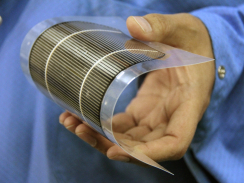forum
library
tutorial
contact

Slicing Silicon Thinner to
Cut the Price of Solar Cells
by Matthew L. Wald
New York Times, March 13, 2012
|
the film forum library tutorial contact |

|
Slicing Silicon Thinner to
by Matthew L. Wald
|
 A California company has unveiled a radical new way to make the silicon wafers that are the basic ingredient of most solar cells, cutting silicon consumption by 90 percent and eliminating the need to use glass and heavy backing to keep the cells rigid.
A California company has unveiled a radical new way to make the silicon wafers that are the basic ingredient of most solar cells, cutting silicon consumption by 90 percent and eliminating the need to use glass and heavy backing to keep the cells rigid.
Twin Creeks Technologies of San Jose says it is ready to ship equipment that can peel off layers of silicon that measure just 20 microns thick. That compares with the 200-micron thickness in common use. At 20 microns, equivalent to about one-fifth the thickness of a layer of paint, the silicon can bend without cracking.
The company is not the first to think of using less silicon; last year the Department of Energy backed a Boston-area company that found a way to cast the wafers at 200 microns.
The conventional method is to grow silicon crystals in great ingots and use a diamond saw to cut them that thin, a process that turns much of the silicon into dust.
But Twin Creeks says it has developed a method for shooting protons, which are essentially hydrogen atoms, into a block of silicon, embedding them to the precise depth desired and then heating the protons so they take up more space. Then the company cracks off a layer in a process it calls "proton-induced exfoliation."
Siva Sivaram, the company's chief executive and founder, compared it to peeling sheets off a pad of Post-it notes.
Manufacturing a standard cell today requires 6.5 grams of silicon per watt of capacity, worth about 40 cents; the new system will use just 600 milligrams and cost 10 cents per cell, he said. The finished product can be wrapped in plastic instead of being covered with a special grade of low-iron glass on a hard backing.
The savings amount to big numbers, Mr. Sivaram said, because the market price of solar cells is now in the vicinity of 85 cents per watt. Hardly any companies are making money at that price, and some have gone bankrupt. The idea is that this technological innovation will help companies cut costs to a level below the market price.
Twin Creeks has produced some finished cells as a demonstration, but its business niche is manufacturing the equipment to make the wafers. Still, Mr. Sivaram pointed out that the cell manufacturers will save money by moving away from glass and solid backings.
The company has a production line in Senatobia in northern Mississippi that can make 25 megawatts' worth of wafers a year and could ramp up to 100 megawatts, he said. Twin Creeks has raised $93 million in venture capital and received $25 million from the state of Mississippi, which has an aggressive program for luring high-tech manufacturing.
Meanwhile, Twin Creeks is looking for other technologies where proton-induced exfoliation could be useful.
learn more on topics covered in the film
see the video
read the script
learn the songs
discussion forum
